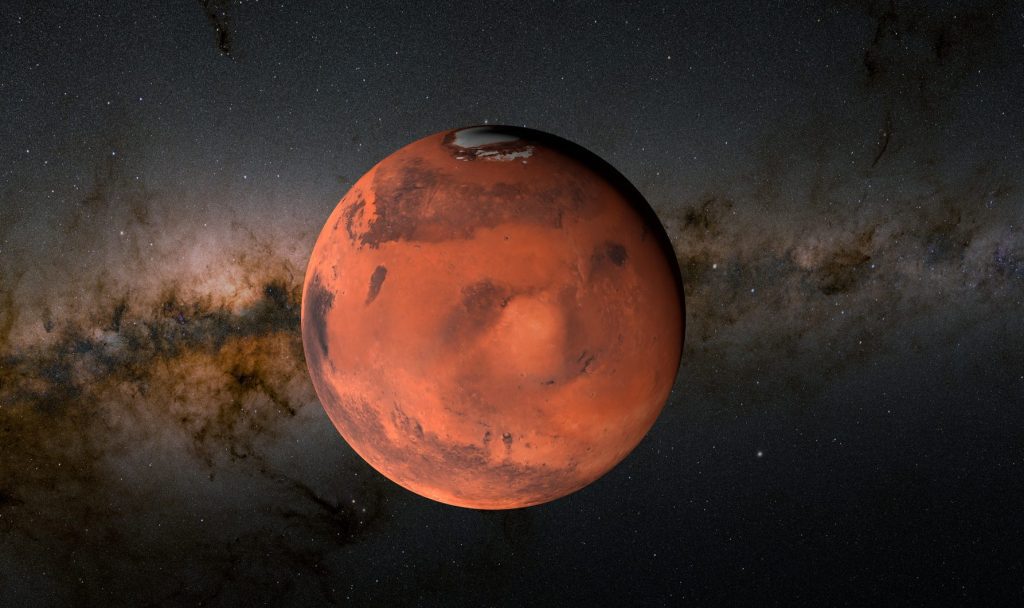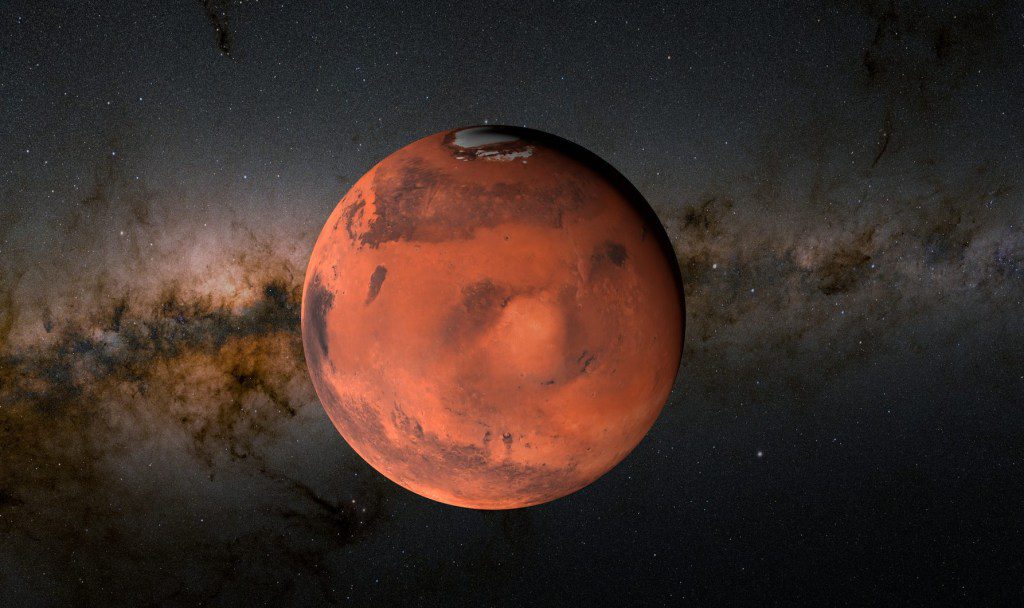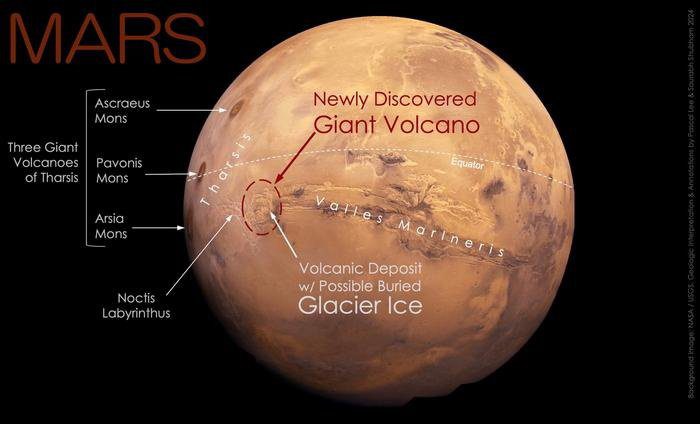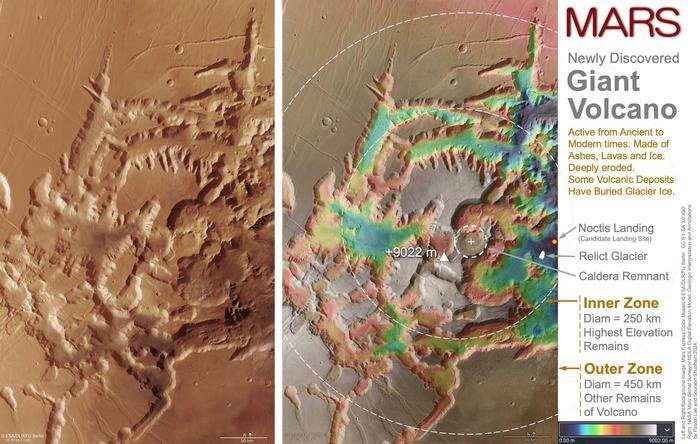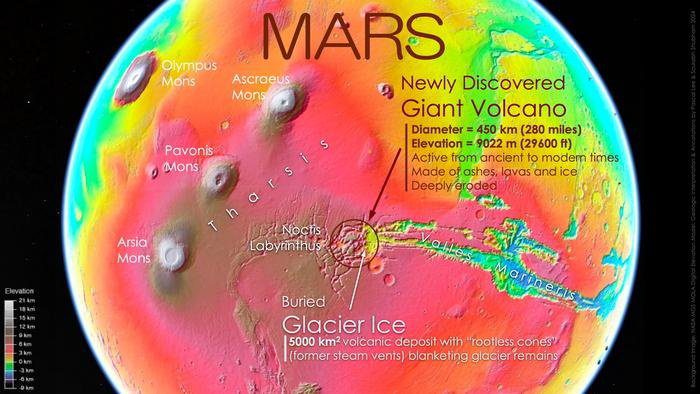A large, possibly active volcano taller than Everest has been found on Mars after being hard to see for a long time and may be a great place for life to develop.
Scientists found the volcano, temporarily called the ‘Noctis’, in the eastern part of Mars’s Tharis province near the equator.
It is 280 miles wide, about the distance from London to Newcastle, and over 9,000 meters tall – a few hundred meters taller than Mount Everest.
The volcano has been observed by Nasa’s orbiting spacecraft since 1971, but it was overlooked because it was very worn down and difficult to recognize.
The team of scientists say the volcano’s size and ‘complex modification history’ suggest it has been active for a long time.
They also think a layer of glacier ice might be buried beneath the volcano – which could provide new information about Mars’s evolution over time.
Lead author Dr Pascal Lee, a planetary scientist with the SETI Institute and the Mars Institute, said: ‘We were studying the geology of an area where we had previously discovered the remains of a glacier when we realized we were inside a massive and highly worn down volcano.
‘In its southeastern part lies a thin, recent, volcanic deposit, beneath which glacier ice is likely still present.
‘The combined giant volcano and possible glacier ice discovery is important, as it points to an exciting new location to study Mars’ geologic evolution over time, search for life, and explore with robots and humans in the future.’
Co-author Sourabh Shubham also said the team had located the volcano in the eastern part of Mars’s Noctis Labyrinthus while studying possible glacier remains nearby.
The team’s analysis showed that the volcano had gone through a long and ‘complex’ period of change over the years – likely due to a combination of fracturing, thermal erosion, and glacial erosion.
Some of this was caused by the accumulation of ice from repeated snowfall, which led to lava rising through different parts of the volcano.
This resulted in the erosion and subsequent collapse of entire sections of the volcano.
Scientists also found evidence of lava flows, hydrated mineral deposits, and pyroclastic deposits – such as ash, cinders, and pumice – in several areas within the volcano’s perimeter.
However, much about the newly discovered volcano remains a mystery, the team admitted.
‘Although it is clear that the volcano has been active for a long time and began to build up early in Mars’s history, it is unknown how early exactly,’ said Mr Shubham.
‘Similarly, although it has experienced eruptions even in modern times, it is unknown if it is still volcanically active and might erupt again.
Was the warmth and ice able to support life at this site if it has been active for a long time?
Dr Lee emphasized that the discovery is still very exciting for further Mars exploration, saying that the heat interacting with ice makes this spot on the planet a great place to look for signs of life.
The Noctis volcano site is exceptionally exciting because of a combination of factors, according to him.
It’s an ancient and long-lasting volcano that has been eroded deeply enough to explore, sample, and date different parts of its interior to study Mars’ evolution through time by hiking, driving or flying through it.
The site has a long history of heat interacting with water and ice, making it an ideal location for astrobiology and the search for signs of life.
Likely with glacier ice still preserved near the surface in a relatively warm equatorial region on Mars, it may be possible to extract water for hydration and for manufacturing rocket fuel.
Therefore, this place is very appealing for robotic and human exploration.
The groundbreaking discovery, made using data from several Nasa missions, was presented at the 55th Lunar and Planetary Science Conference.
The volcano, while huge, is not nearly as tall as Olympus Mons, another volcano on Mars, which is almost 22km tall, two and a half times taller than Everest.





